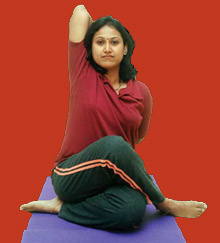 |
Stepping out of his car, the man enters his house. At the foot of the seventeen steps leading up to the landing en route to his bedroom, he hesitates, grimacing. Finally, gritting his teeth, he essays the climb, taking the steps one at a time, pausing after every two. |
The left knee threatens to buckle any time, the pain excruciating, only an ingrained sense of self control keeping him from moaning out loudly. Somehow he makes it all the way up, totters to his bed and… whew! What a relief to just lie down.
Arthritis of the knee, he's told by the "ortho" after a series of tests. Pain killers are prescribed to reduce inflammation of the 'angry' joints; and the man of medicine, wise beyond his profession, prescribes yoga as an effective 'extra mural' supplement to medication - with diligent practice under the guidance of an expert. Our sufferer is told, he can realistically contemplate a return to his 'passion of the evenings' – club tennis - before long.
Yoga as a Preventive Method
In most of us there is a resigned, almost apathetic attitude to middle age health issues, taking them to be matter of course occurrences as the body ages on the exterior - the progressive spread of grey, the appearance of wrinkles, the widening area of baldness; internally, the onset of cholesterol problems, high sugar; and the flaking of cartilages , the resultant rubbing of bones with each other, especially in weight bearing areas like the shoulders, hips and knees i.e. arthritis, understood as simply the result of 'wear and tear'. Kaumaaram, youvanam, jaraa, childhood through youth to old age, says even the Bhagavad Gita, that's the way of all flesh. But Sri Krishna did not mention arthritis and such like as inevitable by-products of old age (and at the time of the Kurukshetra Battle, the Lord in human form was eighty and his disciple, seventy, researchers say!) He was a Yogi, and yoga declares categorically that all the problems mentioned above need not be, in fact shall not be, present in those who have made yoga a way of life. Millions of yoga saadhaks could be examples - they, thanks to commencing yoga early in life, have easily put up a 'No Entry' board to these invasive monsters.
In no other health system are the joints given such a rigourous work out as in yoga. The visuals tell their own tale, more eloquently than any wordy description can. All the poses are unique to yoga, available nowhere else. The shoulder and the knee are depicted here as specific beneficiaries, because arthritis can affect any joint site. With yoga practice, joint spaces are maintained; cartilage jamming is effectively prevented, adequate blood supply is ensured through correct flexions and extensions, and the synovial membrane maintains an optimum level of the lubricant, synovial fluid.
Yoga as Therapy
From general to therapy yoga, it's an enormous step in article writing, which the prudent pro hesitates to take, and for excellent reasons, the written word carries to sections and strata completely beyond the reach of the author and there are subtleties involved in therapeutic applications of general principles. Consider, for example, arthritis as an issue. Among the readers eager for a cure may be persons of different age, physical condition and suppleness, to name only an obvious few. But do they have any other problems? Meaning, there are things which only a personal meeting can clear up. Of yoga it is said that practice should be only under the personal guidance of a competent teacher, even for general purposes. After a few months of such training, if that kind of training cannot be sustained, the teacher suggests suitable books. Always, practicing from the written word will be a second best option. If this be the case with general yoga, what to say when it comes to yoga applied as therapy?
In dealing with arthritis (of the shoulder and knee), therefore, dear reader(s), please rest assured that yoga is an extremely effective means to tackle the debilitating illness. Whatever the acuteness of the problem, exercise is a must, for, every effort should be made to maintain, and to improve upon, the range of movements available to the affected space, otherwise, the joint becomes clinically 'dead'. To learn from the printed word and pictures may lead to areas of quicksand and create more problems. If you are convinced by the writing presented here, please sign up with a teacher worthy of the name. My best wishes to you, in your pursuit of health the Y way! |
 |
T Nandakumar is a yoga exponent based in Chennai. |
|